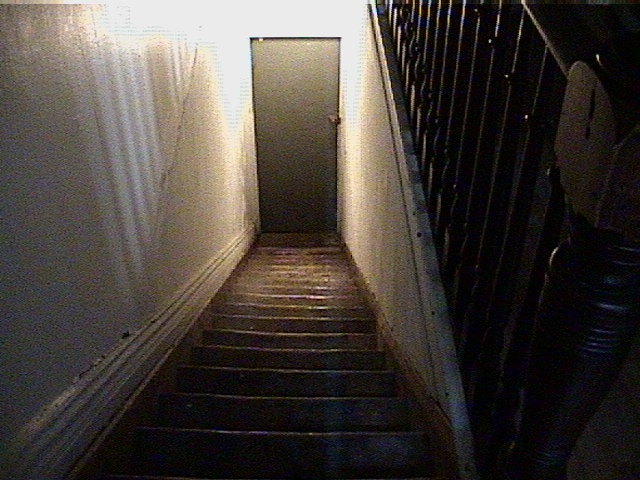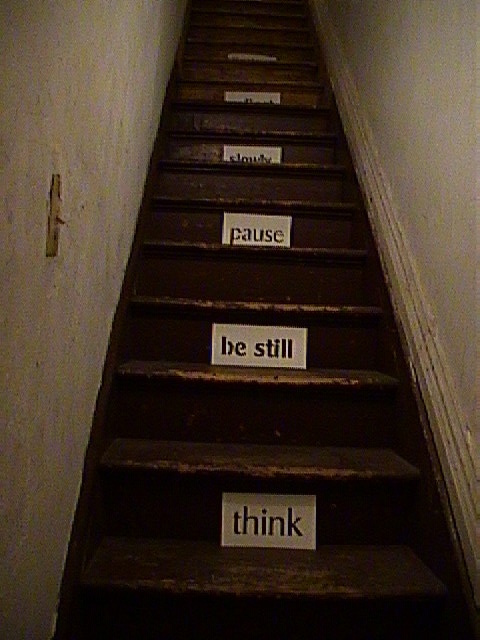Women Artist Links General Art Links Moira Fogarty's Projects Joyce Wieland
Time: Duration Plus Experience




Project 3: Time
Duration Plus Experience
"When a man sits with a pretty girl for an hour, it seems like a minute. But let him sit on a hot stove for a minute - and it's longer than any hour. That's relativity."
Albert Einstein, 1879-1955
Artist's Statement
Time is such a loose and ambiguous concept for me that I found it difficult to think of a way to express my personal experience of time to others. I knew I needed some way to capture a moment, a closed space with a limited duration and a strong feeling attached to it. In the stairwell I use every day, the walls are austerely blank, the tread of each step is old stained wood well worn by the passage of many feet. One light switch operates one lamp, the only light source for the straight line of sixteen steps connecting the grey metal door (without even a handle) to the third floor hallway. A perfectly barren Zen environment for communicating something as flexible and relative as the experience of time. I set up a four-day experience with eight signs designed for the rise of every other stair to be seen on the journey up, and eight signs for the tread of every other stair to be seen on the way down. Each sign had a maximum of two words, usually employing an imperative verb such as "wait", "think", "run", or "faster". The down signs were set up every morning before people left to go out, and the up signs were set up every evening for the advent of people coming home.
The Method Behind the Madness:
The Stairwell - Sharing the personal experience of time is a tricky thing. Meal times would seem an obvious choice, with their sense of ritual and personal preferences, but my eating habits are extremely erratic, and would be nearly impossible to share in a meaningful or comprehensive way with anyone else. Also, the kitchen is a busy place, lacking focus. There are too many distractions to the sort of direct communication I wanted to achieve. Cleaning rituals are also far too personal, and the same arguments can be made against the busy bathroom as can be made against the noisy kitchen. So, the stairwell seemed the obvious choice.
The Signs - A fair deal of consideration was put into the font, colour and placement of each sign. I printed them out in 96 point fonts, so that they would be noticeable and legible all the way from the top to the bottom and vice versa. They were centered to allow for optimum readability and the risers were cut out for the effect of lightness and to let the wood show through, while the treads were left dark black ink to enhance the starkness and because cutting them out would have increased wear and tear considerably, as they were designed to be stepped on.
The Photographs - Taken with a digital camera, photographs were the best way to communicate the immediacy of the experience. The photos were challenging, as I had to operate under very low light conditions, and posing myself in a manner that would express the sign in the picture was sometimes life threatening. The stairs are extremely steep and attempting to get my feet into the frame was quite tricky. Printing and assembling the photos was also difficult, as I had to choose a method of presentation that would reflect the event. I ended up printing them onto 11 x 17 glossy cardstock as 3 x 4 serialized shots. Each picture was centered in the frame and the overall effect was of a film reel playing itself out.
The Reactions - People who used the stairwell generally enjoyed the upward climb, finding the messages soothing and welcoming. Nobody enjoyed them trip down, as the messages imparted a sense of panic, which is just as it should be. Overall, I think the words had the sort of subtle psychological effect I was looking for. Since the experiment's conclusion, I have put the photos in plain glass frames and hung them in the stairwell, which reminds people on a daily basis of how they travel through this space. The photo-display fits in well, and adds a much-needed decorative element to the stairwell.
Ideas that Fell By the Wayside
From the very beginning, I wanted to use the stairwell; I liked the enclosed space, the forced daily ritual, the consistency of duration and emotive experience that it signifies for me. I had other ideas about what to do with it, however. Early thoughts involved placing obstacles in the way of progress or incorporating audio/visual interruptions along the route. After some consideration, I decided that I didn't want to invade the routine by introducing new experiences that would significantly alter it. I merely wanted to enhance the experience that was already contained in the space, subtly, not placing myself too much in the way, but encouraging reflection on how time is experienced in this contained space. I have always admired the art of Yoko Ono and Maya Lin, and their sense of reserve and simple use of words moved me to pare down the concept of altering the space permanently. One of Yoko Ono's early pieces involves the viewer climbing a white ladder, and then upon reaching the top, reading the word "yes" printed in small letters on the ceiling. I wanted this sort of intimacy, to get others involved in my mindset so that they can learn, in a space with minimal other stimulus, how I experience time. I used words that float through my head on a day-to-day basis when I use the stairwell.
Contact me to give advice, comments, or questions at moira.fogarty@utoronto.ca
Personal Influences
Doug Sensei School Heritage Parents Broccoli Olivia Garden Home Japan Music Tori
Tom Dave Madness Maya Lin Northern Exposure
It is the friends that you can call at 4am that matter.
--- Marlene Dietrich
people have visited this site since its creation February 8th, 2000.